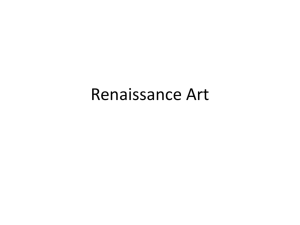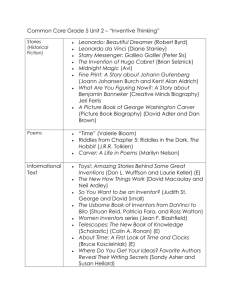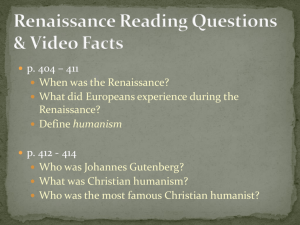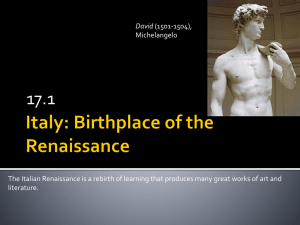CHY4U_Renaissance_Art_2014
advertisement
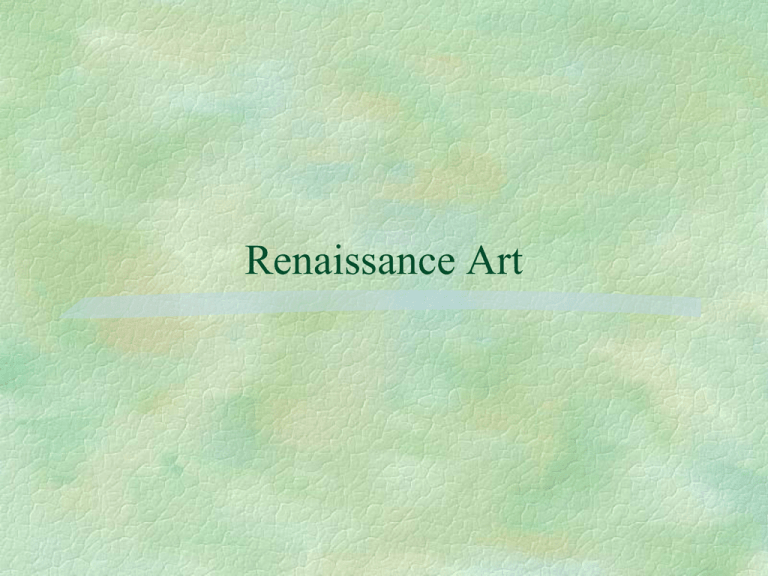
Renaissance Art Out of the Middle Ages [context] Medieval: Early Middle Ages were dark ages because all the learning of the classical age (Greek and Roman) was lost or thought to be pagan. Pagan = vulgar. Sacredness of everything, God always involved in people’s daily lives. God is proximate. Medieval Art Art inspired reverence. Various levels of the Church bureaucracy commissioned art (central = pope, bishops, parishes, monasteries). Metropolitan Museum of Art, Timeline of Art History, 2004 <http://www.metmuseum.org/toah/ho/07/eust/ho_2004.442.htm> (January 19, 2005); Veronica Sekules, Medieval Art: Oxford History of Art (Oxford:Oxford University Press, 2001), 52. Madonna and Child, ca 1300 by Duccio di Buoninsegna. Medieval Art con’t Common subject matter: biblical scenes such as crucifixion, Last Supper, nativity, Virgin Mary. Beauty is god-like, colour and light especially. Altar is where holy communion is given, so it needs to be decorated with a special altarpiece. The Crucifixion, 14th century Italy. Part of a folding, portable altar. The Metropolitan Museum, The Cloisters, Works of Art, Collection Highlights, 2000, <http://www.metmuseum.org/Works_Of_Art/viewOne.asp?dep=7&viewmode=0&item=61.200.1> (January 19, 2005); . Veronica Sekules, Medieval Art: Oxford History of Art (Oxford:Oxford University Press, 2001), 61. Changes in Late Middle Ages Sacred and secular together, not everything has to be related to God. Re-introduction to classical myths and gods. Timeline: 1300 - 1520? Italian Renaissance Starting in the mid 14th century, the commercial cities of northern Italy (Milan, Venice, Florence) were the scene of a great artistic and cultural revival. Historians see it as a transition between the Middle Ages and the modern period. Medieval vs. Renaissance Cathedral Church of San Francesco, Assisi Gothic (stained glass, cross shape). Circle (Classical) rather than the cross (Gothic) The Metropolitan Museum of Art, Timeline of Art History, Italian Peninsula, 2004. <http://www.metmuseum.org/toah/ht/07/eust/ht07eust.htm> (January 19, 2005). Duomo - Santa Maria del Fiore by Brunelleschi (14171434). Octagonal. “Italy” Geography: a collection of city-states; some republics, autocracies and a kingdom. All were wealthy. Northern Italy Northern Italian rulers had money to spend on patronizing the arts. The Medici family (bankers and traders) ruled Florence and sponsored well-known artists such as Botticelli and Michelangelo . Robert J. Walker, World Civilizations: A Comparative Study (Don Mills: Oxford University Press, 1998), 263-264. Florence (Firenze) Home of Donatello, Michelangelo, Brunelleschi, Alberti, Machiavelli, Botticelli, da Vinci, the Medici family. Wealth based on banking, trade and commerce (textiles). Importance of civic institutions Palazzo Vecchio, Florence. Rome The city had been home to the papacy since St. Peter was the first bishop of Rome. It fell into hard times but was revived in the 15th century when it was rebuilt, inspired by Renaissance artistic virtues. Famous art: The new St. Peter’s basilica, Michelangelo’s painting of the Sistine Chapel ceiling. There was great interest in Rome’s ancient ruins. Humanism Study of the liberal arts: grammar, rhetoric, poetry, history, philosophy (also music, astronomy, geometry, theology, arithmetic). Secular: focused on improving life here on earth, not just on the after-life. “Reason over revelation.” Individualistic. Admired the Greeks and Romans. Perpetuated through education (humanist schools). Classicism Revived interest in classical works of Greece and Rome: architecture art more secular WebMuseum, Paris, Botticelli, The Birth of Venus, 2002, <http://www.ibiblio.org/wm/paint/auth/botticelli/ve nus/> (January 25, 2005). Sandro Botticelli, Birth of Venus figures from classical mythology; ideal beauty; earliest nudes. Visual Art & Architecture Humanist Art Portraiture: humans the centre, not the divine. Nature: humanistic focus on realism, this earth. Incorporated the latest advances. Titian, Venus of Urbino (nudes recall the classical love for ideal beauty). Artistic Advances of the Renaissance Linear perspective: Method of portraying realism. Foreshortening - gives a 3-D effect. Anatomy Michelangelo’s sculpting and painting of realistic musculature. <L’assentesplinder.com> (January 25, 2005); Sister Wendy Beckett, The Story of Painting (Toronto: Little Brown (Canada), 1994), 84-85. Masaccio, The Trinity, 1425. Leonardo da Vinci [art reflects age] Born 1452 near Florence, died 1519 in France. Worked for the duke of Milan as a military and civil engineer, sculptor. Known as “Renaissance Man” for his many interests - reflecting the humanism, science, and learning of the era. National Gallery, Leonardo da Vinci Biography, <http://www.nationalgallery.org.uk/cgibin/WebObjects.dll/CollectionPublisher.woa/wa/artistBiography?artis tID=384> (January 2005). Leonardo Self Portrait, 1516. Leonardo’s Science Anatomy: dissected corpses to get accurate drawings. Notebooks: 5000 pages of flying machines, submarines, parachutes, weapons, thread-cutting machine, water wheel. “It seems to me that those sciences are vain and full of error which do not spring from experiment, the source of all certainty.” Boston Museum of Science, Renaissance Man: Scientist, <http://www.mos.org/leonardo/scientist.html> (January 25, 2005). Anatomical drawing. Leonardo’s Use of Perspective Leonardo da Vinci, study for Adoration of the Magi, showing all the lines needed to create perspective. Exploring Linear Perspective, Boston Museum of Science, 1997.<http://www.mos.org/sln/Leonardo/ExploringLinearPerspective.html> (January 25, 2005). Leonardo’s Artistry Mona Lisa - 1505 - a portrait of the wife of a Florentine merchant. Sfumato - skillful use of shading, natural appearance: “how distance fades colours, how shadows modulate, and how surfaces pick up the reflected tints of nearby objects.” Focus on the way the viewer interacts with the painting. WebMuseum, Paris. Leonardo Da Vinci, La Jaconde, 2002, <http://www.ibiblio.org/wm/paint/auth/vinci/joconde/> (January 25, 2005). Mona Lisa Michelangelo Buonarroti Born 1475 Florence, died 1564. Sculptor and painter. Very religious. Felt beauty is divine. Sculpted David (15011504) 14 feet high - a biblical figure made to reflect the power and freedom of Florence. WebMuseum, Paris, Michelangelo, 2003 <http://www.ibiblio.org/wm/paint/auth/michelangelo> (January 25, 2005). Pieta Pieta, 1375-1400, German Body of the dead Jesus Christ in his mother’s arms. Michelangelo’s version does not depict agony but nobility. Shown in St. Peter’s. Metropolitan Museum, Works of Art, <http://www.metmuseum.org/Works_Of_Art/viewOne.asp?dep=7&viewmode=0&item=48 .85> (January 19, 2005); Christus Rex, Basilica di San Pietro I - Michelangelo,k Pieta, Michelangelo and the Vatican Painted the ceiling of the Sistine Chapel (80 feet high) in the Vatican combining Greek and Roman mythology and Old Testament figures. Designed the new St. Peter’s basilica - modeled the dome on the one in Florence. Christus Rex, Basilica di San Pietro, Esteriore, 2000, <http://www.christusrex.org/www1/citta/B2-Dome.jpg> (January 25, 2005). Michelangelo’s dome. Plan by Michelangelo. Sistine Chapel Michelangelo worked here 1508 to 1512. The holiest chapel because it is where popes prayed. Vatican Museums Online, Sistine Chapel, 2003, <http://mv.vatican.va/3_EN/pages/CSN/CSN_Main .html> (January 25, 2005). The Sistine Chapel. Sistine Chapel Ceiling The Creation of Man Layout of the Ceiling, Michelangelo’s Cistine Chapel Ceiling, 2001, <http://sun.science.wayne.edu/~mcogan/Hum anities/Sistine/Ceiling/index.html> (January 19, 2005); WebMuseum, Paris. Michelangelo, 2003, <http://www.ibiblio.org/wm/paint/auth/michel Raphael (Raffaello Sanzio) Born 1483, died 1520. Used the latest techniques such as perspective to paint naturally and realistically. Influenced by Leonardo and Michelangelo (also painted at the Vatican and for a time was the chief architect of the new St. Peter’s basilica). St. Catherine of Alexandria, 1507-08. Known for grace and movement. National Gallery, Past Exhibitions, <http://www.nationalgallery.org.uk/exhibitions/raphael/default.htm> (January 25, 2005). School of Athens - Raphael Painted 1510-1511. Classical figures include Plato, Aristotle, Pythagoras, Ptolemy, and Euclid. Renaissance figures include Michelangelo, da Vinci, and himself. School of Athens classical references Sister Wendy Beckett, The Story of Painting (Toronto: Little Brown (Canada), 1994), 128. Raphael con’t School of Athens painted in the pope’s private apartment (library and private office). Note: Averroes. Christus Rex, Stanze e Loggia di Raffaello, 2000, <http://www.christusrex.org/www1/stanzas/0Raphael.html> (January 25, 2005). Global Influences A new school of thought holds that the Renaissance was partly spurred by nonwestern influences, other than Greek and Roman. Chinese Islamic (800 years of Al Andalus, Islamic Spain) – India via Islam? Islamic Influences Islamic knotwork motif on Italian plate, 1500-1520 The Getty, 2004, The Arts of Fire: Islamic Influences on the Italian Renaissance http://www.getty.edu/art/exhibitions/arts_fire/ (July 1, 2009). Islamic Influences, con’t Sicily (Normans) and Cordoba and Toledo (Moors) were major areas for transmission of: Math Philosophy Medicine Architecture John M. Hobson, The Eastern Origins of Western Civilization. Cambridge: Cambridge University Press, 2004. From Google Books (July 1, 2009). 179-182 Abbasid Caliphate, th 9 Century Baghdad: access to Indian numbering system (became Arabic numerals) University of Arkansas at Little Rock. Applications: web-based Precalculus. 2001. http://ualr.edu/lasmoller/aljabr.html (August 14, 2009). Back in Time Islamic society in Spain (Al Andalus) was more open to reason than Europe well before the Renaissance 800s: Al Khwarizmi • Algebra, astronomy, circumference of the earth 1100s: Averroes (Ibn Rushd): • Medicine, astronomy, law, philosophy (commentaries on Aristotle) BBC Radio. In Our Time: Averroes. 2006. http://www.bbc.co.uk/radio4/history/inourtime/inourtime_20061005.shtml (August 14, 2009). Averroes Avicenna 1000s: Avicenna (Ibn Sina) • Medical encyclopedia (Canon on Medicine) The “Persian Galen” at work Canon, 1632 Arabic copy A Unesco medal honouring Avicenna quotes him: “Cooperate for the well-being of the body and the survival of the human species.” William and Kathleen McKee, World History: Connections to Today. Teacher’s Ed. Upper Saddle River, New Jersey: Prentice-Hall, Inc., 2001. 261-266. Wellcome Library. Avicenna’s Canon of Medicine. http://library.wellcome.ac.uk/doc_WTX023437.html (August 14, 2009). Washington State University, College of Pharmacy, History of Pharmacy. 2009. http://www.pharmacy.wsu.edu/HISTORY/history13.html (August 14, 2009). UNESCO. Avicenna Medal. 2002. http://portal.unesco.org/en/ev.php-URL_ID=26452&URL_DO=DO_PRINTPAGE&URL_SECTION=201.html (August 14. 2009). Bibliography Annenberg/Corporation for Public Broadcasting. Middle Ages. 1997. <http://www.learner.org/exhibits/middleages/>. Beckett, Sister Wendy. The Story of Painting: The Essential Guide to the History of Western Art. Toronto: Little Brown (Canada), 1994. Boston Museum of Science. Leonardo da Vinci. 1997. <http://www.mos.org/leonardo/>. Christus Rex et Redemptor Mundi. 1997. <christus.rex.org>. Dersin, Denise (ed.). What Life Was Like at the Rebirth of Genius: Renaissance Italy AD 1400-1550. Alexandria, Virginia: Time-Life Books, 1999. King, Ross. Michelangelo and the Pope’s Ceiling. New York: Penguin Group, 2003. Layout of the Ceiling, Michelangelo’s Cistine Chapel Ceiling, Wayne State University Humanities. 2001. <http://sun.science.wayne.edu/~mcogan/Humanities/Sistine/Ceiling/in dex.html>. The Metropolitan Museum of Art. Works of Art. The Cloisters. 2004. <http://www.metmuseum.org/Works_Of_Art/department.asp?dep=7>. The Metropolitan Museum of Art. Timeline of Art History. 2004. <http://www.metmuseum.org/toah/splash.htm>. McDonald, Jesse. Michelangelo. London: PRC Publishing Ltd., 2001. National Gallery. 2005. <http://www.nationalgallery.org.uk/default.htm>. Sekules, Veronica. Medieval Art: Oxford History of Art. Oxford:Oxford University Press, 2001. Vatican Museums Online. 2003. <http://mv.vatican.va/3_EN/pages/MV_Home.html>. Walker, Robert J. World Civilizations: A Comparative Study. Don Mills: Oxford University Press, 1998. WebMuseum, Paris. The Italian Renaissance. 2002. <http://www.ibiblio.org/wm/paint/tl/it-ren/>.
